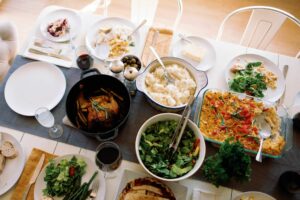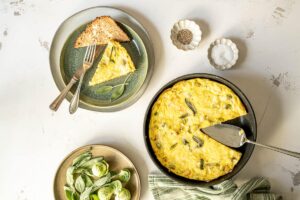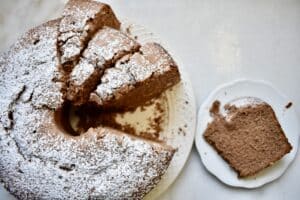Imagine you’re walking through the French countryside. The sun is high and your stomach rumbly as you approach a charming cottage à l’heure du déjeuner, and you notice a sweet-faced grand-mère gathering some of the fruits from her garden. She smiles, beckons you inside, and invites you to sit down to a table of delights: crusty sourdough bread, Gruyère coated in ashes from the wood-stove, a platter of dried fish brushed with olive oil and grilled, crocks of cornichons, and a variety of vegetables in olive oil. You savor each of these delicacies, and then she brings to the table a bowl of dried apples and elderflowers, and a crock of Cinnamon Dark Red Plums. As you sip your Elderberry Wine you think this must be heaven.

When asked where all of this wonderful food came from, the kind-hearted mémère shrugs her shoulders and points out the window to her garden. And you realize that she is part of a centuries-long food culture that you don’t share. But you want to.
I’ve pulled Preserving Food Without Freezing or Canning off of the library shelf more than once. But I was always looking at it in the midst of the harvest season, when I had a laundry basket of peaches and boxes of plums waiting to be put…..somewhere, somehow, and as quickly as possible. The techniques in the book were too overwhelming to think about while standing surrounded by produce that was decaying while I took time to gather materials and confidence.
But when Chelsea Green Publishing sent me a copy* in the fall, I was glad to have a chance to sit with a cup of tea on a snowy day and dream about stringing apple slices and tying bouquets of herbs to dry. And come harvest-time 2014 I intend to be ready with some drying screens, twine, and cheesecloth. I’m so excited to try out these time-honored traditional recipes with the fruits from my own garden.
The book is compiled by a French non-profit association, Terre Vivante. Terre Vivante is dedicated to “promoting a way of life that is respectful of the natural environment”. One of their activities has been publishing an organic gardening magazine, Les Quatre Saisons du Jardinage (Four-season Gardening). When they asked readers to submit their time-honored methods of preserving fruits and vegetables, they received over 500 recipe submissions. 250 of the best are presented here. Some of them are classics and you may already have family recipes for them (like sauerkraut, beet kvass). But some are totally new, some adapted from traditional recipes, and some have never been published before because they are regarded as “common knowledge”.
The compilation keeps each contributor’s voice intact, which makes each recipe as charming as though your grandmother wrote it on a tea-stained recipe card. Because of this, you’ll notice that some quantities are rather vague (how much is “a bit” of soy sauce?) while others are terribly specific (“2/3 pound diced apples, rather tart–pippin type” leaves no room for doubt). Thus the authors encourage you to approach the book in the spirit in which it’s written, “a spirit of curiosity, adventure, and improvisation”. However, you are also encouraged to use your common sense and be careful in using these methods, as there are no freezing or boiling temperatures to act as a bacterial safety net in case of careless preparation.
As the book is not intended to be a history book of preservation methods, but a practical guide to preserving with these methods, we should make our peace with the sterile-American-germ-a-phobe that lies deep within all of us who have grown up in much of the western world. The extreme method employed by most preservation techniques–boiling and freezing–is intended to flat out kill the microorganisms lying on our food. But, assuming the food is safe to eat at the moment at which it is preserved, one can use a less-extreme method of simply preventing the microorganisms from spreading. You can do this by placing the food into an environment that is inhabitable by bacteria where they can’t multiply using temperature, acidity, water, and salt to your advantage. Modern methods of preservation, canning and freezing, have made us think that preserved food ought to be “placed forever in suspended animation”, still table-ready after years in the cupboard. But really, the purpose of preserving food is simply to have it last until the next harvest-time, a year at most. The recipes in this book aren’t intended to be shelf-stable for years, rather they are meant to be consumed within weeks or months, until the garden starts yielding fruit again.
Preserving Food focuses on eight basic methods of traditional food preservation, all heavily used before the industrial revolution gave us canning and freezing methods: root cellaring; dehydrating; lactic fermentation; and preserving in oil, vinegar, salt, sugar, and alcohol. Each of these methods, as noted in the foreword by Eliot Coleman, enhance the life found in the food, making it more nutrient dense, or more digestible, or more flavorful. These methods add something to food being preserved, which can give us (in the words of Deborah Madison) “food that sings, not the blues of freezer burn and heavy syrup, but the joyful chorus of elemental flavors wrought by sun and air, salt and vinegar, fat and fermentation.”
I recommend Preserving Food Without Freezing or Canning as a delightful read on a winter day, with a cup of tea and a pencil in hand to note processes and recipes you want to try. I also recommend it as a practical guide for the harvest season, for the simplest and most straightforward methods of preserving your harvest throughout the winter. It is a charming book, whose humble binding belies its romantic contents. A treat for any gardener or foodie, you will surely be pleased to regain knowledge of these time-honored methods and put them into practice in your own kitchen.
Cinnamon Dark Red Plums
This recipe was contributed by Patrick Eude of Le Havre, and is published here with permission from Chelsea Green Publishing.
Source: Preserving Food without Freezing or Canning
Course: Condiments
Serves:
Ingredients
- 2 lbs. dark red plums
- 1 quart cider vinegar
- 1⁄3 cup brown sugar
- 6 cloves
- 1 cinnamon stick
- 1 tablespoon pink peppercorns
- cloth
- needle
- saucepan
- Canning jars and lids
Directions
- Choose plums that are not too ripe. Wash and dry them carefully with a cloth. Pierce them with a needle in three or four places, right down to the pit. Put the plums in jars.
- Pour the vinegar into a saucepan. Add the brown sugar, cloves, and cinnamon; bring this to a boil for five minutes. Remove the pan from the heat and add the pink peppercorns. Carefully pour the hot vinegar over the plums, until they are well covered.
- Let the jars cool, close them tightly, and store them in a cool, dry, and dark place.The plums will be ready to use in about four weeks.
- Sweeter than most condiments, they are exquisite with cold meats, stews, and other hearty dishes. Without the cloves and pink peppercorns, they can even be used as a pie filling.









